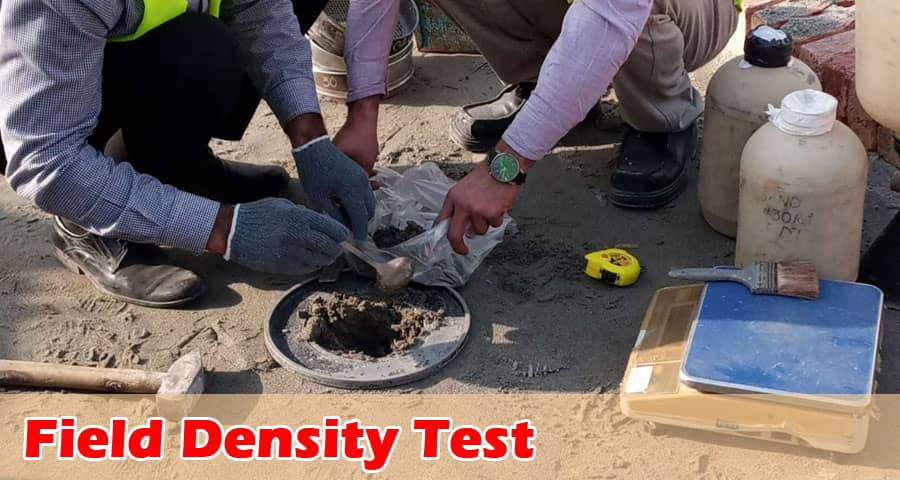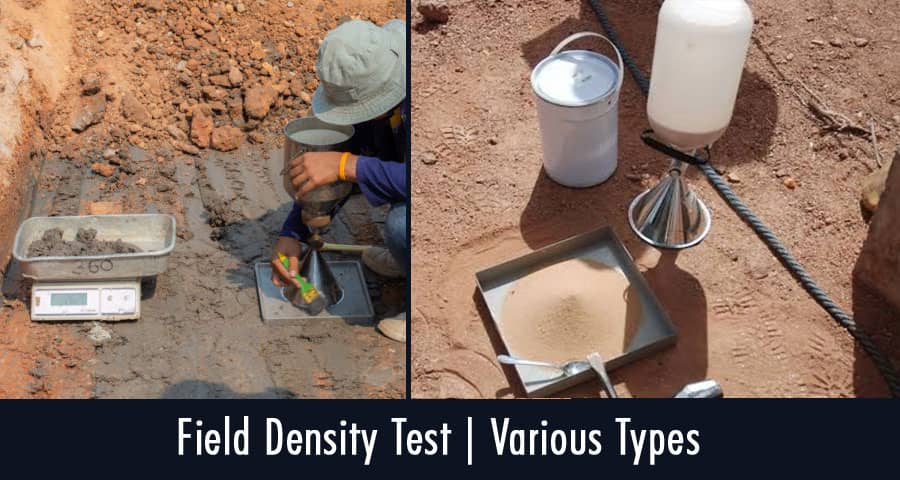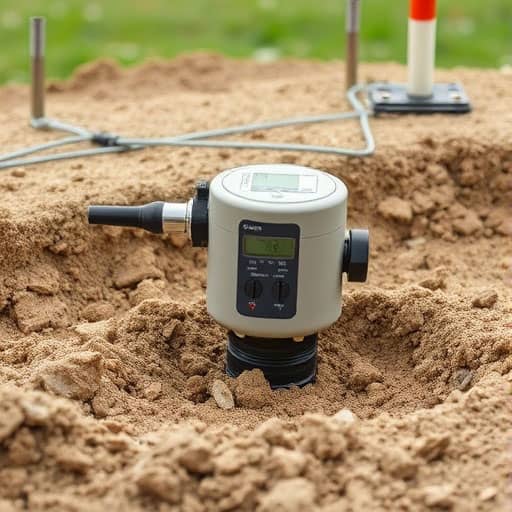What Is Field Density Test? Various types of field density tests

Introduction
In the field of civil engineering and construction, ensuring the proper compaction of soil is crucial for the stability and durability of structures. One method used to determine the compaction characteristics of soil is the field density test. This test helps engineers and construction professionals assess the density and moisture content of soil at a construction site, allowing them to make informed decisions about compaction methods and verify if the desired level of compaction has been achieved.
Understanding Field Density Test
- Purpose of Field Density Test: The primary purpose of the field density test is to measure the in-place density of soil. By knowing the density, engineers can determine if the soil has been compacted sufficiently, ensuring its load-bearing capacity and resistance to settlement. The test also helps in evaluating the suitability of soil for specific construction purposes, such as the construction of roads, foundations, or embankments.
- Importance of Field Density Test: The field density test is vital in construction projects as it ensures the quality and stability of soil compaction. Improper compaction can lead to several issues, including excessive settlement, reduced bearing capacity, and increased potential for structural failure. By conducting field density tests, engineers can identify and rectify any compaction issues early on, saving both time and costs.

Types of Field Density Tests
There are several methods available to perform field density tests. Here are three commonly used methods:
- Sand Cone Test: The sand cone test is a widely used field density test method. It involves excavating a hole in the soil and determining the volume of the hole by filling it with sand of known density. By comparing the weight of the excavated soil to the weight of the sand used, the density of the soil can be calculated.
- Balloon Density Test: The balloon density test is another method to determine field density. In this test, a small hole is dug, and a flexible rubber balloon is inserted into the hole. The balloon is then inflated with a known volume of air, and the pressure required to inflate it is measured. By comparing the pressure readings, the density of the soil can be determined.
- Nuclear Density Test: The nuclear density test utilizes a nuclear gauge to measure the density of soil. This non-destructive testing method involves emitting gamma rays into the soil and measuring the backscattered radiation. Based on the intensity of the backscattered radiation, the density of the soil can be determined.
Performing the Field Density Test
Equipment Required
To perform a field density test, several pieces of equipment are necessary. These include:
- Test hole excavation tools (e.g., shovel, auger)
- Sand cone apparatus (for the sand cone test)
- Balloon and pressure gauge (for the balloon density test)
- Nuclear gauge (for the nuclear density test)
- Moisture content testing equipment (e.g., oven, balance)

Test Procedure
The specific test procedure may vary depending on the chosen method, but generally, it involves the following steps:
- Select a representative location for testing.
- Excavate a test hole to the required depth.
- Perform moisture content testing on the excavated soil.
- Conduct the chosen field density test method (e.g., sand cone test, balloon density test, nuclear density test).
- Record the necessary measurements and observations.
- Repeat the test at multiple locations for accurate results.
Interpreting Field Density Test Results
- Calculating Field Density: The field density is calculated by dividing the weight of the excavated soil by its volume. The calculated density is then compared to a standard density value to determine the percentage of compaction achieved. This comparison helps determine if the soil has been adequately compacted or if further compaction is required.
- Comparison with Standard Density: The standard density value is usually obtained from laboratory tests on a compacted soil sample. It represents the maximum achievable density for the soil under ideal conditions. By comparing the field density with the standard density, engineers can assess the level of compaction achieved and make any necessary adjustments to the compaction process.
Factors Affecting Field Density Test
Several factors can influence the field density test results. Understanding these factors is essential to ensure accurate and reliable test outcomes. Some of the significant factors include:
- Moisture Content: The moisture content of the soil significantly affects its compaction characteristics. Optimum moisture content is required for achieving maximum compaction. If the soil is too dry or too wet, it may not achieve the desired density. Therefore, it is crucial to consider moisture content during the field density test.
- Soil Type: Different soil types have varying compaction properties. Some soils may be more easily compacted, while others may require more effort and specific compaction methods. The type of soil encountered at the construction site should be taken into account when performing the field density test.
- Compaction Method: The method used for compacting the soil can impact the test results. Different compaction methods, such as vibratory compaction or impact compaction, may yield different densities. It is important to use the same compaction method during the field density test that will be employed during the actual construction.
Applications of Field Density Test
The field density test finds applications in various construction projects. Some of the common applications include:
- Construction Industry: The field density test is extensively used in the construction industry for quality control and assurance purposes. It ensures that the soil used for backfilling, embankments, or other structural elements meets the required compaction standards.
- Road and Highway Projects: Road and highway projects rely on proper soil compaction to ensure the longevity and stability of the pavement. Field density tests help ensure that the subgrade and base materials are compacted to the required specifications.
- Foundation Construction: In foundation construction, it is crucial to achieve a high level of soil compaction to support the weight of the structure effectively. Field density tests help engineers assess the compaction quality of the soil beneath the foundation.
Advantages and Limitations of Field Density Test
| Advantages | Limitations |
|---|---|
|
|
Conclusion
Field density tests play a crucial role in construction projects by ensuring the proper compaction of soil. These tests help engineers evaluate the density and moisture content of soil, allowing them to make informed decisions regarding compaction methods. By performing field density tests, construction professionals can minimize the risk of settlement, increase the load-bearing capacity of soil, and enhance the overall stability of structures.
Please watch following Short video for Field Density Test
FAQs
What is the purpose of a field density test?
A field density test is performed to measure the in-place density of soil and ensure proper compaction for stability and load-bearing capacity.
How is the field density test performed?
The test involves excavating a hole, performing a density measurement method (e.g., sand cone test, balloon density test, nuclear density test), and comparing the results with a standard density value.
Can field density test results vary for different soil types?
Yes, different soil types have different compaction properties, which can lead to variations in field density test results.
Are there any alternative methods to determine soil compaction?
Yes, alternative methods such as dynamic cone penetration test and plate load test can also be used to assess soil compaction.
Is the field density test applicable to all construction projects?
The field density test is applicable to a wide range of construction projects where proper soil compaction is essential, including roads, foundations, and embankments.
